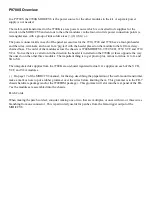
iii
DANGER
When an engine is operating, keep the service area WELL VENTILATED or attach
a building exhaust removal system to the engine exhaust system. Engines produce
carbon monoxide, an odorless, poisonous gas that causes slower reaction time and
can lead to serious personal injury or loss of life.
SAFETY WARNINGS
Always perform automotive testing in a safe environment.
Wear safety eye protection that meets ANSI standards.
Keep clothing, hair, hands, tools, test equipment, etc., away from all moving or
hot engine parts.
Operate the vehicle in a well-ventilated work area, for exhaust gases are
poisonous.
Put the transmission in PARK (for automatic transmission) or NEUTRAL (for
manual transmission) and make sure the parking brake is engaged.
Put blocks in front of the drive wheels and never leave the vehicle unattended
while testing.
Be extra cautious when working around the ignition coil, distributor cap, ignition
wires and spark plugs. These components create hazardous voltages when
the engine is running.
Keep a fire extinguisher suitable for gasoline, chemical, and electrical fires
nearby.
Do not connect or disconnect any test equipment while the ignition is on or the
engine is running.
Keep the test equipment dry, clean, free from oil, water or grease. Use a mild
detergent on a clean cloth to clean the outside of the equipment as necessary.
Do not drive the vehicle and operate the test equipment at the same time. Any
distraction may cause an accident.
Refer to the service manual for the vehicle being serviced and adhere to all
diagnostic procedures and precautions. Failure to do so may result in personal
injury or damage to the test equipment.
To avoid damaging the test equipment or generating false data, make sure the
vehicle battery is fully charged and the connection to the vehicle DLC is clean
and secure.
Do not place the test equipment on the distributor of the vehicle. Strong
electro-magnetic interference can damage the equipment.




































